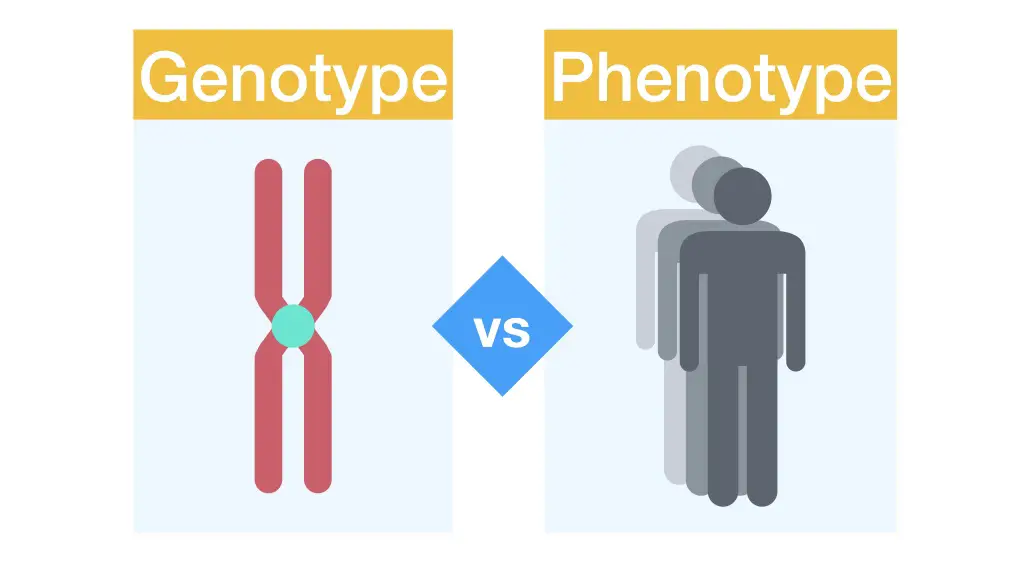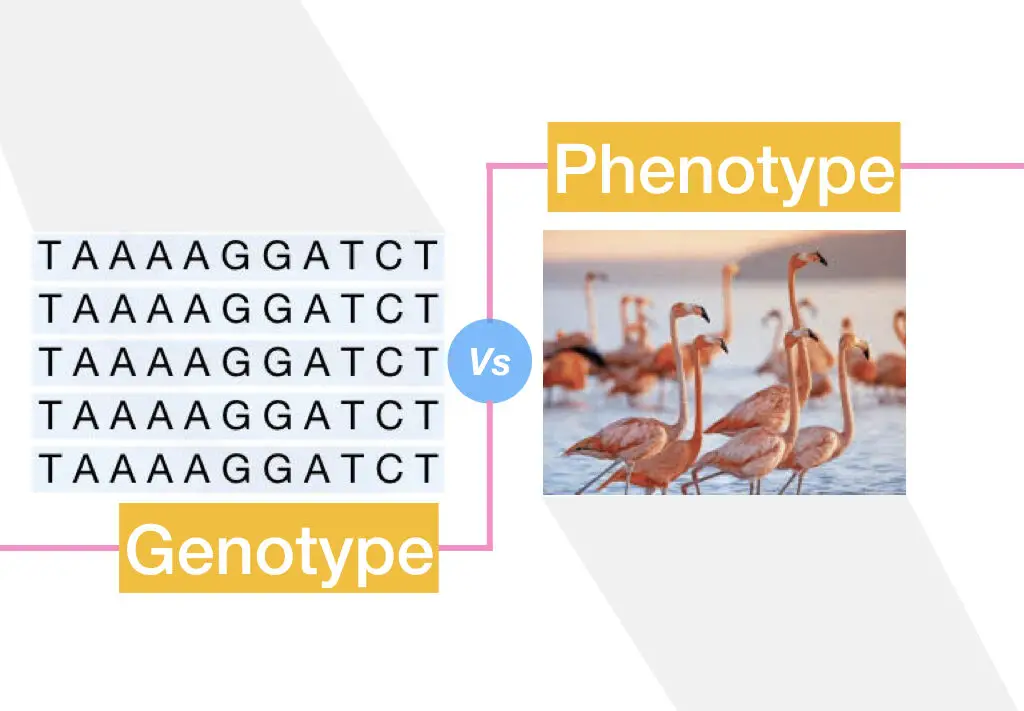“A genotype is the genetic makeup of an organism while a phenotype is a visible character of an organism.”
A field of studying DNA, genes, and chromosome is known as genetics. It includes so many confusion terminologies like homozygous, heterozygous, recessive, dominant, alleles, gene, genotypes, and phenotypes, etc.
Here in the present article, we will teach you two of the most common and confusing terminologies used in genetics that is genotypes and phenotypes. but before understanding that let’s quickly go through some basics.
DNA is everything for us, without it we are nothing, first of all. A functional unit of our DNA- a DNA sequence is known to us as a gene and its alternative forms are known as alleles. You can learn more regarding both the terminologies here: Gene vs Allele.
Now let us broadly understand the whole mechanism, first. Genes form proteins while noncoding or non-functional DNA regulates gene expression. All types of proteins are formed from genes.
For example, eye coloration is governed by some genes which encode a special type of proteins to create different eye color shades. Those group of protein-coding genes is known as eye color genes.
So the entire genetic makeup or DNA (including genes and non-coding DNA) forms various eye colors is collectively known as genotype. While what type of eye color developed from that genotype is known as the phenotype. Although, not only the genetic factor but also environmental factors are crucial for deciding a phenotype.
Let’s discuss some of the basic differences between both.
Key Topics:
Genotype vs phenotype
See the image below,

“The genetic makeup of an organism is referred to as genotype”, this definition is one of the most common and globally accepted definitions for a genotype. But what if I tell you that it’s not complete or partially true!
All the genetic makeup or DNA is our genome, not genotype.
“The genetic makeup of an organism which governs a single specific trait or group of traits to create some phenotype is known as genotype.” This one is the perfect definition of a genotype.
Contrary, “observable characters, set of characters or visible properties of an organism occurring due to interaction between genotype and environment is known as the phenotype.”
Thus, a genotype is a genetic property of an organism while the phenotype is a physical or observable property of an organism.
The phenotype is a final product of a gene therefore we can say that the genotype can influence the phenotype but a phenotype can’t influence a genotype. It literally means that change in genotype causes phenotypic change but phenotypic change can’t alter the genotype.
A genotype is less influenced by environmental factors while a phenotype is greatly influenced by environmental factors.
In fact, with genotype, environmental factors play a crucial role in deciding a particular trait or phenotype. This is the reason even though the genotype remains the same, phenotype changes from organism to organism.
Furthermore, due to the involvement or environmental factors, phenotypes may change over time but the genotype remains unchanged, however, mutation may happen in genotype sometimes.
Based on different alleles, genotypes may either homozygous dominant/ recessive or heterozygous dominant/recessive. We can denote various genotypes as TT, Tt, tt, AA, etc while phenotypes are denoted as tall, shart, dwarf, dark, light, black, white, etc.
How a genotype expresses is completely depends on the DNA sequence of a gene while the expression of a phenotype depends on both genotype and environmental factors.
As we said a genotype consists of both coding and non-coding information which means both expressive and non-expressive DNA sequences. In contrast, the phenotype only originated from the protein-coding sequences i.e from genes only.
A genotype is an inherited property which means it is inherited to offsprings while the phenotype is non-inherited.
A DNA sequence for hair color can be inherited by a person to its offspring but specific, brown hair color of that person can’t be inherited.
A genotype is studied using genetics and genomics techniques like PCR, DNA sequencing, and DNA microarray while a phenotype is studied only by observing physical characteristics by genetic counseling only. A sequencing variation (mutation), sequence order, and copy number variations for a genotype can be studied by PCR, DNA sequencing, and microarray, respectively.
On the other hand, through a series of genetic counseling sessions phenotyping observations and associated problems can be identified.
The frequency of a gene or genotype can be calculated using population genetics tools like HW law. Using which, we can measure the prevalence of a genotype in a population.
Although, we can also calculate a phenotypic frequency of the population we can’t predict it’s occurrence. What does it mean?
Two persons have the same gene sequence for skin color- the same genotype but their skin color differs. Likewise, so many peoples in a population might have the same genotype for skin color but their skin color shades will not be the same.
Related article:
Genotype in a nutshell:
What is a genotype?
A genotype is a genetic composition for one particular trait. It’s not-observable characteristic, can be measured, instead. We can measure a genotyping frequency of a particular genotype in the entire population consequently we can measure its prevalence.
In a simple language, we can say, genotypes are the possible genetic variants for a gene, for example, the OCA2 is a gene for eye and skin color but OCA2AA, OCA2BB, and OCA2AB are different genotypes of it having different phenotypes to produce.
Genotype example:
OCA2 and TYRP1 are two of the genes that are responsible for the production of various skin colors. Various alleles are created due to mutations genes responsible for skin color. For Example, The OCA2 C>T at position 99 can produce darker skin color while the normal allele can produce lighter skin color.
Using p2 + 2pq + q2=1 is the equation using which we can calculate the genotyping frequency.
Phenotype in a nutshell:
What is a phenotype?
A phenotype is a product of a genotype type- observable, visible, and physical characters of the organism. With a genotype, the intrinsic and extrinsic environments also involved in deciding a phenotype.
Using the same HW equation, a phenotypic frequency can be determined. The place, food, habit, lifestyle, temperature, and other factors play an important role in deciding one’s phenotype.
Usually, it can be changed over time and can temporarily change the genotype as well. However, those changes are non-inherited.
Phenotype example:
Flamingos are naturally white in color however, we have seen pink or vibrant pink flamingos. A color phenotypic color change in flamingos are the classic example of genotype and environmental influence on phenotype.
As we said the bird is naturally white but their food habits make them pink or vibrant pink.

Conclusion:
Variations known as epigenetics occur due to factors like genotype, the function of non-coding DNA, and the environment.
Epigenetic changes alter phenotype greatly even without changing a genetic code or genotype. Gene’s expression changes as the environmental changes and hence it causes phenotypic change.
Sources:
Orgogozo V, Morizot B, Martin A. The differential view of genotype-phenotype relationships. Front Genet. 2015;6:179. Published 2015 May 19.
Subscribe to our weekly newsletter for the latest blogs, articles and updates, and never miss the latest product or an exclusive offer.



